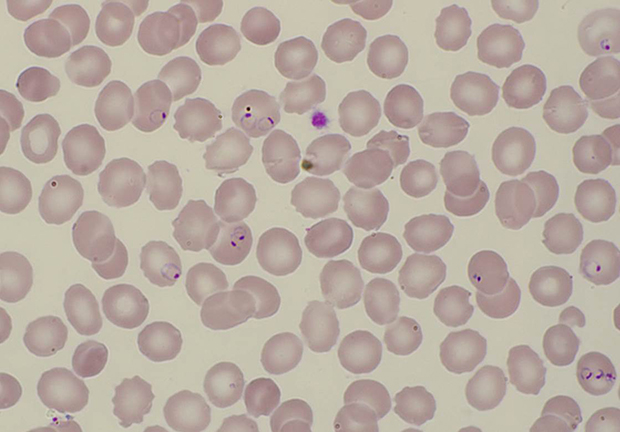1. Mayxay M, Pukrittayakamee S, Newton PN, White NJ. Mixed-species malaria infections in humans. Trends Parasitol. 2004; 20(5):233–240.


2. Leder K, Black J, O'Brien D, Greenwood Z, Kain KC, Schwartz E, et al. Malaria in travelers: a review of the GeoSentinel surveillance network. Clin Infect Dis. 2004; 39(8):1104–1112.


3. Snounou G, Viriyakosol S, Zhu XP, Jarra W, Pinheiro L, do Rosario VE, et al. High sensitivity of detection of human malaria parasites by the use of nested polymerase chain reaction. Mol Biochem Parasitol. 1993; 61(2):315–320.


4. Ciceron L, Jaureguiberry G, Gay F, Danis M. Development of a
Plasmodium PCR for monitoring efficacy of antimalarial treatment. J Clin Microbiol. 1999; 37(1):35–38.


6. Lysenko AJ, Beljaev AE. An analysis of the geographical distribution of
Plasmodium ovale
. Bull World Health Organ. 1969; 40(3):383–394.


7. Cornu M, Combe A, Couprie B, Moyou-Somo R, Carteron B, Van Harten WH, et al. Epidemiological aspects of malaria in 2 villages of the Manyemen forest region (Cameroon, Southwest Province). Med Trop (Mars). 1986; 46(2):131–140.

8. Doctor SM, Liu Y, Anderson OG, Whitesell AN, Mwandagalirwa MK, Muwonga J, et al. Low prevalence of
Plasmodium malariae and
Plasmodium ovale mono-infections among children in the Democratic Republic of the Congo: a population-based, cross-sectional study. Malar J. 2016; 15(1):350.



9. Menner N, Borchert M, Dieckmann S, Ignatius R, Mockenhaupt FP. Uncommon manifestation of a mixed-species malaria infection: cryptic falciparum malaria in a traveler with successfully treated tertian malaria. J Travel Med. 2012; 19(2):133–135.


10. Jeong AC, Ahn BJ, Choi CK, Yoon KS, Nam HW, Lee WJ, et al. A case of mixed malarial infection with Plasmodium falciparum and Plasmodium vivax
. Korean J Infect Dis. 1998; 30(2):194–197.
11. Kim JM, Yoo TH, Park CJ, Chi HS. A mixed cerebral infection of vivax and falciparum malaria. Korean J Clin Pathol. 2000; 20(3):263–267.
12. Shin KS, Kim JS, Ryu SW, Suh IB, Lim CS. A case of Plasmodium vivax infection diagnosed after treatment of imported falciparum malaria. Korean J Clin Pathol. 2001; 21(5):360–364.
13. Shin SY, Yu JH, Kim JY, Kim YJ, Woo HY, Kwon MJ, et al. A case of mixed malaria infection with severe hemolytic anemia after travel to Angola. Infect Chemother. 2012; 44(5):386–390.

14. Collins WE, Jeffery GM.
Plasmodium ovale: parasite and disease. Clin Microbiol Rev. 2005; 18(3):570–581.


15. Tanga MC, Ngundu WI, Tchouassi PD. Daily survival and human blood index of major malaria vectors associated with oil palm cultivation in Cameroon and their role in malaria transmission. Trop Med Int Health. 2011; 16(4):447–457.


16. Mehlotra RK, Lorry K, Kastens W, Miller SM, Alpers MP, Bockarie M, et al. Random distribution of mixed species malaria infections in Papua New Guinea. Am J Trop Med Hyg. 2000; 62(2):225–231.


17. Bigaillon C, Fontan E, Cavallo JD, Hernandez E, Spiegel A. Ineffectiveness of the Binax NOW malaria test for diagnosis of
Plasmodium ovale malaria. J Clin Microbiol. 2005; 43(2):1011.


18. Roucher C, Rogier C, Sokhna C, Tall A, Trape JF. A 20-year longitudinal study of Plasmodium ovale and Plasmodium malariae prevalence and morbidity in a West African population. PLoS One. 2014; 9(2):e87169.
19. Khairnar K, Martin D, Lau R, Ralevski F, Pillai DR. Multiplex real-time quantitative PCR, microscopy and rapid diagnostic immuno-chromatographic tests for the detection of
Plasmodium spp: performance, limit of detection analysis and quality assurance. Malar J. 2009; 8(1):284.


20. Okell LC, Ghani AC, Lyons E, Drakeley CJ. Submicroscopic infection in
Plasmodium falciparum-endemic populations: a systematic review and meta-analysis. J Infect Dis. 2009; 200(10):1509–1517.






 PDF
PDF Citation
Citation Print
Print




 XML Download
XML Download